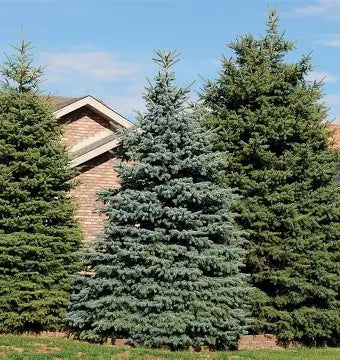Riverdene Garden Centre
Colorado Spruce
Colorado Spruce
Couldn't load pickup availability
Colorado Spruce / Blue Spruce (Picea pungens) Care Guide
Overview:
Known commonly as Blue Spruce or Colorado Spruce, Picea pungens is a striking evergreen conifer valued for its silvery-blue to bluish-green needles, dense pyramidal form, and durability in colder climates. It serves well as a specimen tree, windbreak, or accent in landscapes.
1. Planting & Growing Conditions
-
Hardiness Zones: 4 through 7 (some sources list down to Zone 3)
-
Mature Size:
-
Height: typically 30–60 ft (9–18 m) in landscape settings
-
Spread: 10–20 ft (3–6 m)
-
-
Growth Rate: Slow to moderate — often ~12 inches (30 cm) per year once established
-
Light Requirements: Full sun (at least 6 hours of unobstructed sunlight) is ideal for color and vigor
-
Soil Requirements:
-
Prefers moist, well-drained soils (loam, sandy loam)
-
Tolerates a wide range of soils including slightly acidic or neutral pH
-
Avoid heavy clay soils with poor drainage — root rot is a risk
-
-
Spacing: Leave 10–15 ft (3–4.5 m) between trees to allow for mature width and airflow
2. Watering & Establishment
-
First Year: Provide regular deep watering to help the root ball establish — keep soil moist (but not waterlogged)
-
After Establishment: Tolerates some drought, but benefits from supplemental watering during prolonged dry periods, especially in summer
-
Mulching: Use 2–3 inches of organic mulch around the base (keeping it away from the trunk) to help conserve moisture and moderate soil temperature
3. Fertilizing
-
Apply a balanced, slow-release fertilizer in early spring if the tree shows signs of nutrient deficiency
-
Use organic matter, compost or well-rotted manure at planting to improve soil structure
4. Pruning & Maintenance
-
Best Pruning Time: Late winter to early spring, before new growth begins
-
How to Prune:
-
Remove dead, damaged, or diseased branches
-
Light thinning may be done to improve air circulation, but avoid cutting into old wood, as spruce do not regenerate well from deep pruning
-
5. Foliage, Seasonal Interest & Wildlife
-
Needles: Stiff, four-sided, sharply pointed needles, typically 0.75–1.25 in (2–3 cm) long, arranged radially around twigs
-
Color: The attractive bluish-silver hue is due to a waxy coating on needles
-
Form: Conical / pyramidal when young; lower branches may droop slightly with age
-
Wildlife Use: Provides cover and nesting sites for birds. Seed cones are a minor food source.
6. Pests & Diseases
-
Common Problems:
-
Needle cast, tip blight, and fungal pathogens in humid or wet conditions
-
Spruce spider mites or adelgids (in dry stress conditions)
-
Root rot in poorly drained sites
-
-
Preventive Measures:
-
Ensure good air circulation
-
Avoid overhead watering during humid weather
-
Maintain tree health to resist pest attacks
-
Remove and destroy infected branches
-
7. Winter & Cold Protection
-
Naturally cold-hardy — no special winter protection is usually needed in its suitable hardiness zones
-
Mulch root zone before winter to buffer temperature fluctuations
-
In areas with heavy snow/ice, gently shake snow from branches to prevent breakage
8. Landscape Uses
Beautiful specimen or focal tree in gardens
Windbreaks or visual screens when planted in rows
Accent tree for its striking bluish foliage
Use in mixed evergreen borders
Also popular as a slow-growing Christmas tree variety
Photo from Foothills Nursery
Share


